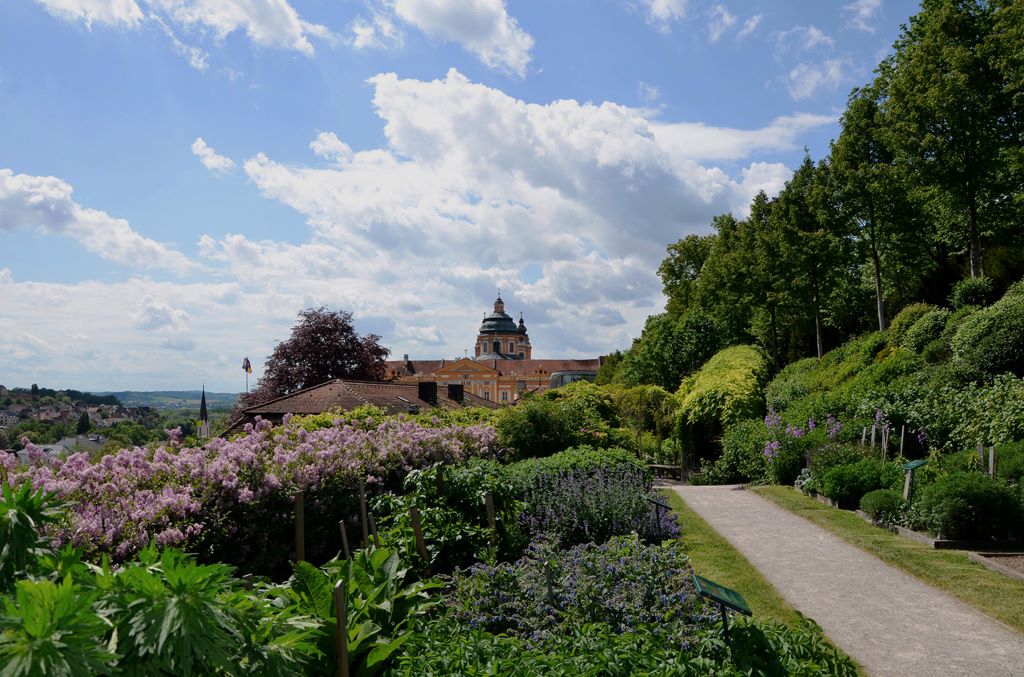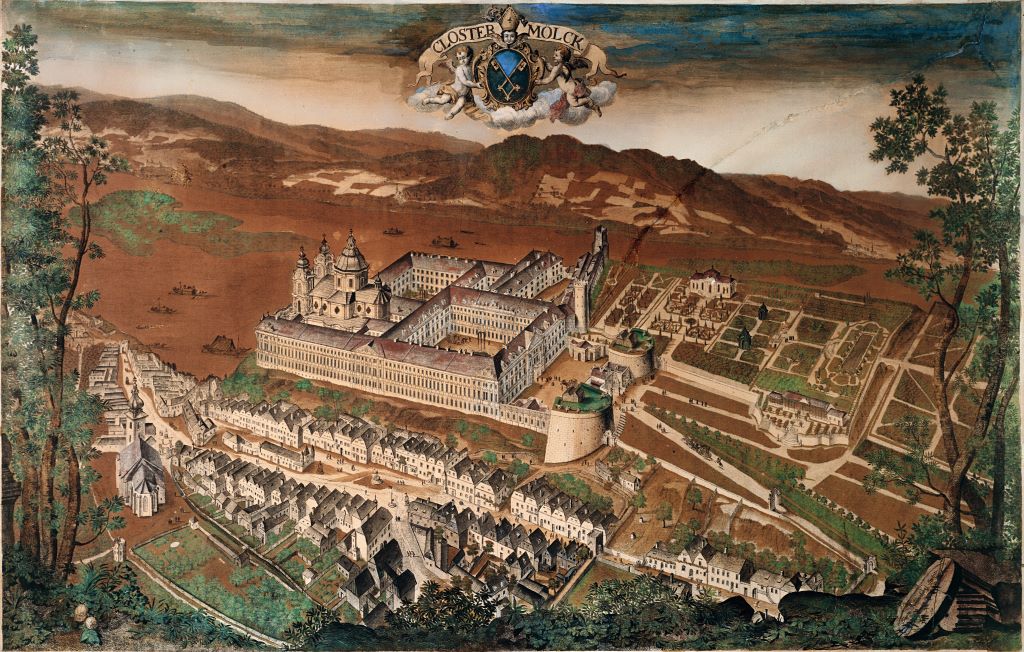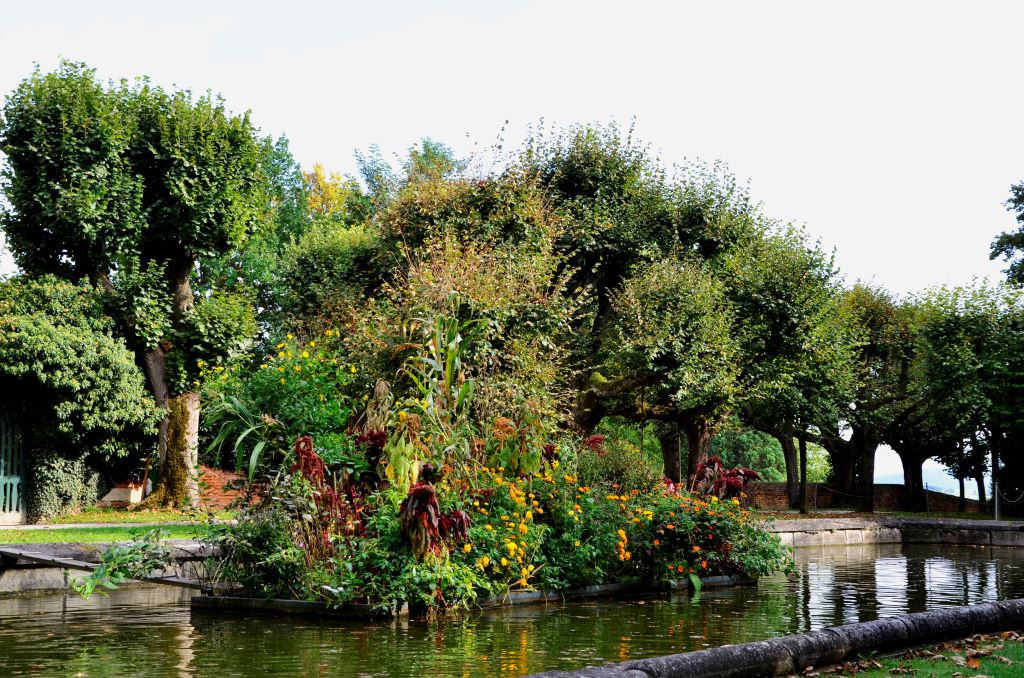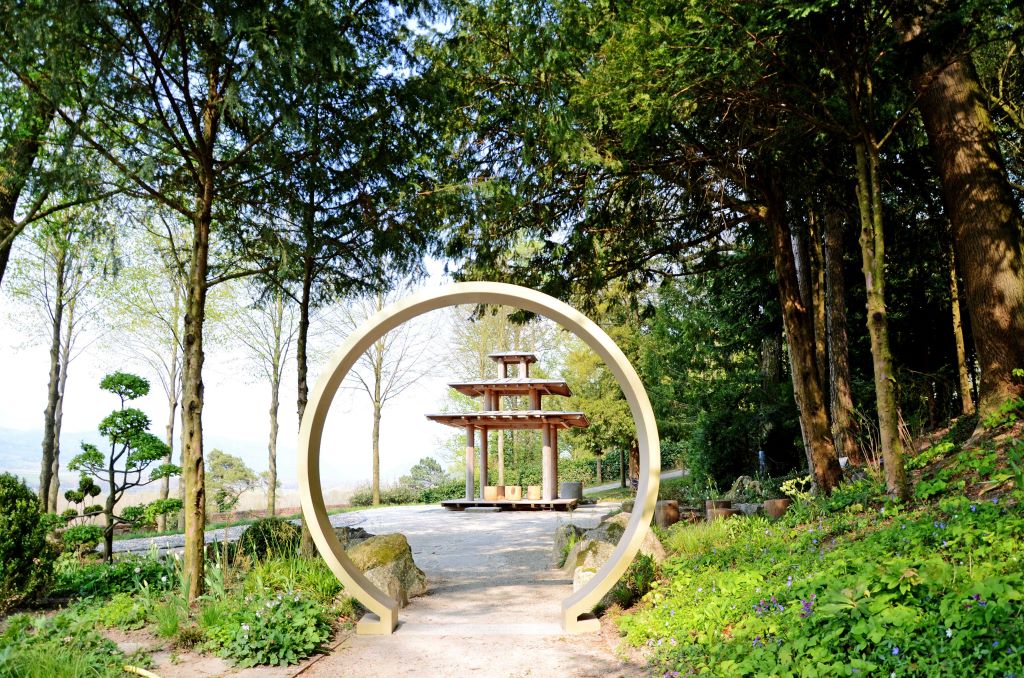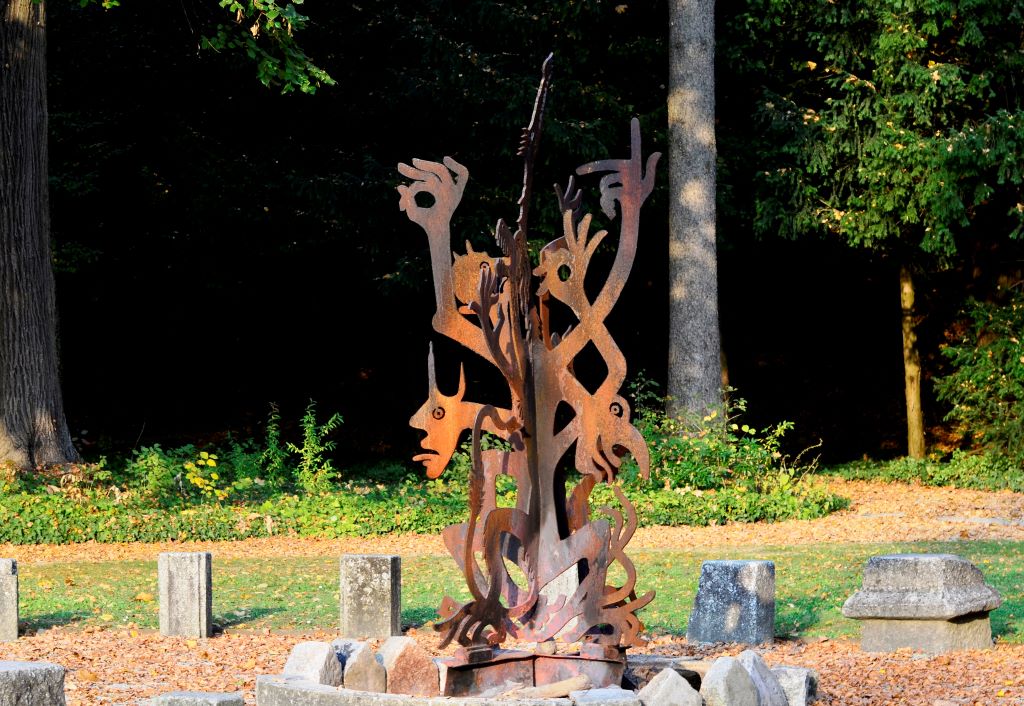“The abbey park does not only reflect its 250-year-long history, but also attests to Humanity’s and Nature’s power of creation. Through the constant interaction of architecture, Nature, and spirituality the abbey park has become a unique park landscape.”
Melk Abbey Park
unique park landscape
Map of the abbey park
With the support of the Federal Monuments Office and the help of Franz and Edith Bodi Melk abbey’s park was revitalized and subsequently opened for visitors in 2000: a wonderful garden to complement Melk abbey’s buildings awaits visitors.
The defining influences for the abbey park were the movements of the Baroque garden aesthetic and the English landscape garden, both of which still determine the park’s character. Depending on financial feasibility and zeitgeist the appearance of the abbey park has undergone constant change. Since the revitalization of the 1990s many new ideas have been implemented and integrated into the park.
Following plans by DI Dr. Alfred Benesch new areas were created in Melk abbey park: the Cabinet Clairvoyée in the northwestern corner, the Paradise Garden in the southern section which includes the Walafrid Strabo Garden and the Mediterranean Garden, or the Oriental Garden in the northeastern corner. Since the opening of the abbey park in the year 2000 it has also been a setting for installations and sculptures by contemporary artists. With the restauration of the Northern Bastion an important hub between the abbey buildings and the abbey park was created. Its panoramic terrace offers a beautiful view of the gardens.
The Baroque garden pavilion with its exotic frescoes by Johann W. Bergl, the Oriental Garden with a view of the Danube valley, Saint Benedict’s Path with texts for meditation, the historical water basin with the New World, surrounded by 250-year old linden trees, the Walafrid Strabo Garden and many other accents are waiting to be discovered during a stroll through the gardens.
Visitor information for the abbey park
Melk abbey park is open daily, from April to October, between 9.00 am and 6.00 pm.
Park admission is included in the ticket for the abbey visit.
Guests who are interested only in the gardens can get tickets for the park only, without a visit of the abbey building.
Adult € 5.50
Student (17-27 years) € 4.00
Child (6-16 years) € 1.50
Map of the abbey park
Melk Abbey Park
Areas & interesting facts
“The abbey park is an important witness to garden art and the cultural history of Austria. It is a significant complement to Melk abbey’s buildings, because the edifices and the gardens constitute a distinctive ensemble and must be considered a unity.” Father Martin Rotheneder
Since most of the old manuscripts were destroyed by a devastating blaze in the abbey library in the 13th century, one can only guess how the abbey complex was structured at that time. According to the Rule of Saint Benedict a monastery should be built in a way that all necessities like water, mill, and garden were inside the monastery.
Because of the Rule of Saint Benedict and the Plan of Saint Gall (9th century) which depicts an ideal monastic compound, we can assume that small vineyards and patches for the cultivation of vegetables and fruit were situated in the rough terrain around the monastery complex.
According to the prevalent Baroque ideas of a garden as a paradise and adapted to the topographic conditions of the area, the Baroque abbey park was created in the 18th century, replacing the abbey’s former vineyard and orchard. Melk abbey park developed its current uniqueness and identity in the last centuries due to ever changing attitudes towards garden art. Even financially challenging times, when it was not possible to pay for garden maintenance, and Nature reconquered and overgrew the cultivated park, have made a contribution to its appearance. During the fifteen-year-long revitalization of Melk abbey park, old structures, some of them from the Baroque age, have been made visible again.
“In the Baroque age harmony between the exterior and the interior was extremely important. Experts made us realize that the park area is of the highest quality. Melk abbey park is considered an appropriate complement to the world-famous abbey buildings. There are fascinating parallels between the building and the park.” Father Martin Rotheneder
During the revitalization process the master plan behind the garden architecture became clearer and clearer. There are intriguing correspondences between the building and the park:
If you mirror the building with the gardens (using the two 1000-year-old Babenberg Towers as an axis), the lantern of the abbey dome and the Baroque water basin meet at the same point.
The lantern is considered the third level of Melk abbey church. There, a fresco depicts the Holy Spirit (the third divine person) in the form of a dove:
No life without spirit!
The abbey park also has three levels. On the third level the Baroque water basin is situated, surrounded by 250-year-old linden trees:
No life without water!
And here the circle of this fantastic overall idea is complete: Spirit and Nature, intellect and emotion. The “complete” person is addressed.
“The eye-catcher on the lower level of Melk abbey park is the Baroque garden pavilion. After the completion of the abbey buildings Abbot Thomas Pauer commissioned Franz Munggenast with its construction. Erected between 1747 and 1748, the garden pavilion was intended for the recreation of the monks after strict fasting periods. A place to address the senses was created. In the pavilion you can feel the incredible desire for all things exotic, which was typical of the Baroque age. The newly discovered exotic world was brought into the building and depicted there.” Father Martin Rotheneder
Exotic frescoes by Johann Wenzel Bergl
With a great amount of imagination Johann W. Bergl created an exotic place to linger, with strange animals, intertwining jungle plants and indigenous people. True to the purpose of the pavilion the subject of the frescoes over the windows and doors of the main room is the world of the senses. The ceiling fresco shows the sun in the center and below the four seasons. At the edges of the ceiling fresco the four then known continents are represented.
In the smaller rooms you can see an abundance of exotic plants, animals and fruits. Details in the ceiling fresco like Lady Fortune emptying her cornucopia, angels playing cards, or angels with billiard cues suggest that this room was used for playing games.
In front of the pavilion many different roses were planted to emphasize the garden pavilion’s beauty with their pink blossoms.
Cultural events in the Baroque garden pavilion
During the summer months the main room of the Baroque garden pavilion also serves as a venue for concerts, for example during the International Baroque Music Days at Pentecost or for the summer concerts in August.
“The creation of a paradise garden has greatly enriched the abbey park. These last years, it has become the heart of the park grounds.” Father Martin Rotheneder
The Paradise Garden in the southeastern corner of Melk abbey park was designed in the year 2000 during the revitalization of the park: an exotic, Mediterranean garden space which was created in remembrance of the former orangery, with elements of a symbolic paradise garden.
Through a tunnel pergola guests reach the Place in Paradise, from where one path leads to the lower level, the Mediterranean Garden, and another to the Walafrid Strabo Garden.
The Mediterranean Garden presents itself in modern architecture. This area of the park references the abbey buildings. A steel strip with a Latin inscription indicates the central axis which connects Saint Coloman’s altar in the abbey church with the recently planted palm tree in the Mediterranean Garden. The inscription above Saint Coloman’s altar “The righteous shall flourish like the palm tree” continues in the Mediterranean Garden with the inscription „May God keep you vigorous in eternal virtue, and may the palm tree of imperishable life shelter you”.
Blossoming – fragrant – healing ǀ Walafrid Strabo Garden
In the upper level guests can visit the Walafrid Strabo Garden where something blossoming, fragrant, or healing is growing all year round. This paradise garden proper has been planted according to guidelines from the didactic poem “De cultura hortorum” by the Benedictine abbot Walafrid Strabo (abbot on Reichenau Island in the 9th century) and was complemented with plants which are well suited to the main plants of each patch.
„one garden
one moment
ONE BREATH OF WIND
ONE DREAM
ONE DESIRE
ONE WISH
ONE STATUS
ONE INSIGHT
ONE LAUGHTER
ONE EXISTENCE”
Hans Hoffer
In 2014 the area around the wooden pavilion was remodeled according to Eastern influences, if only allusively.
The wooden pavilion (built for a final exam at the Technical University in Vienna) was originally constructed with only wooden joints. Metal screws were added later to make it more stable against gusts of wind.
“Thus I see God in his works. The more I strive to grasp his infinite essence, the less I comprehend it.” Jean Jacques Rousseau
High hornbeam hedges grown on arches form small garden spaces from which visitors can enjoy a fantastic view of the Danube valley. Two big rotating mirror prisms mark the western end of an alley and playfully bring the landscape and light into the hedge spaces. Here the mirrors and the glass stones on the ground capture the last beams of the setting sun from the west and reflect them.
The quote on the iron plate on the ground at the entrance of the Cabinet Clairvoyée “Thus I see God in his works. The more I strive to grasp his infinite essence, the less I comprehend it.” is by Jean Jacques Rousseau – a writer from the age of Enlightenment – from 1762. Around that time the frescoes in the garden pavilion were painted.
“Gently staged presentations, integrated into the historic abbey park, bespeak the unifying harmony between nature and art.” Father Martin Rotheneder
Since the opening of the abbey park in the year 2000 it has also been a setting for installations and sculptures by contemporary artists.
Talking Stones
On the abbey park’s second level the Talking Stones (staged by Hans Hoffer) speak about the seven days of Creation as told in the book of Genesis.
Gor Chahal
The installation’s title Beyond the Horizon refers to linear perspective in painting – perfected in the Renaissance – which makes the spatial relation between objects in the physically tangible world visible with the help of descriptive geometry.
Laurus Edelbacher
The Father, the Son and the Female Spirit, a sculpture made of marble from the Wachau
sponsored by Wiener Städtische Versicherungsverein
This sculpture from 2014 is a commissioned work created by the young artist Laurus Edelbacher. Its subject was to be symmetry as well as the number three. The sculpture’s name is The Father, the Son and the Female Spirit, because in contrast to European culture the Hebrew word for spirit is female. The spirit is the life-giving, the life-nurturing element. And since it is the woman who brings new life into the world, the spirit is female. No life without spirit.
Miguel Horn
Iron sculptures created by Miguel Horn can be found along the paths on the second level of the abbey gardens. His “fire demons” are situated at the fire pit. The sculptures have remained in the park since the special exhibition Fantasies in Iron on the abbey grounds in 2002.
Ingrid Kralovec
The Ravens by Ingrid Kralovec line the eastern beechwood hedges on the lower level of the abbey gardens. When reading the former abbot Burkhard Ellegast’s book “Der Weg des Raben” (“The Way of the Raven”) she had the idea to create a larger series of raven sculptures.
Christian Philipp Müller
The “New World” by Christian Philipp Müller, an object artist from Switzerland, was created on the occasion of the commemorative Mozart year in 2006 in cooperation with Art in Public Space in Lower Austria. The idea behind this work was to let plants grow here which, in the time of Mozart, had just recently come to us from America, while his music was reaching America: corn, tomatoes, tobacco, sunflowers, potatoes etc….
sponsored by EVN
Josef Friedrich Sochurek
"Pleiades" – the seven wooden crosses
“Having opened our eyes to the deifying light, let us hear with awestruck ears what the divine voice, crying out daily, doth admonish us.”
RB Prologue 9
Through a gentle visual and acoustic presentation Saint Benedict’s Path imparts important wisdom and elemental beliefs from Saint Benedict’s monastic rule.
Many people don’t know much about monasteries. Some believe that people living in monasteries only pray, forsake all mundane and exciting things and shut themselves off from the world. Then there are those who have the ideal perception that only good people are living in a monastery who are always of one mind and soul.
Worldwide about 17.000 Benedictine nuns and about 9.000 Benedictine monks are living in monasteries, following the Rule of Saint Benedict, which he wrote in the 6th century in the abbey of Monte Cassino. Since 1089 there have always been Benedictine monks living in Melk Abbey, without interruption.
Saint Benedict’s Path calls attention to various typical Benedictine points of view. The thoughts expressed by the author of Saint Benedict’s Path, Melk’s former abbot Dr. Burkhard Ellegast, bespeak his own decades of effort to live according to Saint Benedict’s Rule. In addition, Saint Benedict’s Path also offers passages from former abbot primate Notger Wolf’s book “Worauf warten wir? (What are we waiting for?)”
Saint Benedict’s Path is intended to encourage us to consciously set boundaries, to respect rules, and yet to constantly learn to keep moving. It points out possibilities to forge one’s own path in one’s own particular situation.
Saint Benedict’s Path is situated in the Northern part of Melk abbey park, east of the garden pavilion. Upon 12 stands visitors find quotes from Saint Benedict’s Rule and reflections about it. Music can be heard as well (Saint Benedict’s Song).
BOOK TIP:
Der BENEDIKTUSWEG im Melker Stiftspark ǀ VIA BENEDICTI MELLICENSIS
by abbot em. Dr. Burkhard Ellegast OSB
€ 6,90
available (in German language only) in Melk abbey’s gift shop or online at shop(at)stiftmelk.at
Abbey Park Regulations
You are on historic grounds from the Baroque period. The different park levels are not secured, the historical water reservoirs are without fences. Therefore we ask visitors to stay on the paths and to be especially cautious to guarantee their safety as well as the maintenance of the park.
- In case of wind or storm please immediately leave the area under the historical trees.
- It is forbidden to pluck or dig up plants.
- Dogs may not be brought onto the park grounds.
- It is allowed to take photos or videos for private purposes. For photos and videos for commercial purposes as well as wedding and engagement photos a written permit is necessary (at least 7 days in advance, available at foto(at)stiftmelk.at )
- Instructions of the abbey staff must be followed. Failing that, the person(s) concerned may be banned from the premises.
- The entrance ticket is to be kept and presented on request. It loses its validity when the ticket holder leaves the park.
- The Stift Melk Card is valid only when accompanied by a photo ID.
- The park grounds must be left before closing time.
- Please help to keep the park clean and use the provided waste containers.
- The opening times can vary due to weather conditions.
- Certain areas may be closed because of scheduled events.
- It is forbidden to leave the paths or to step on the lawn (except for the area around the fire pit).
- It is not allowed to enter cordoned off areas.
- Parents are responsible for their children.
- Children under 14 years may only enter accompanied by an adult.
- Melk Abbey cannot be held responsible for events resulting from disregard of these safety precautions. Enter at your own risk.
